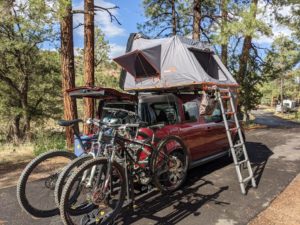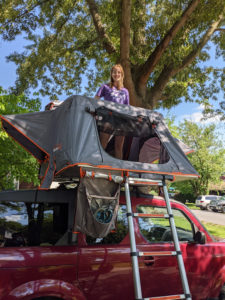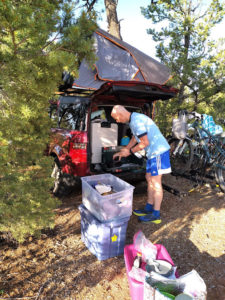Roofnest Condor Review
Title: Roofnest Condor Review
This article is about the Roofnest Condor rooftop tent, which we bought a little over a year ago in 2021. For those thinking about purchasing a rooftop tent, I hope this article helps your research process along.
I have to say that I really wanted to love this tent, but it feels like we are headed for a breakup. That said, the tent has performed well for us overall, and Roofnest’s customer service is top notch. Our first delivery arrived damaged, but Roofnest made things right, but this is another story, detailed in the video linked here.
So let me get to the PROs and CONs of this rooftop tent.
PROs:
-

Roofnest Condor in the wild…somewhere in New Mexico. Set-Up, Part I: It’s pretty great to roll into a campsite, size up your spot and pop up your tent and it’s just done. If you’re a ground tent person, you know that there is a process involved in setting up a tent, securing the rainfly, adjusting the lines as needed so your tent doesn’t blow away or get soaked in a storm. It takes about 5-10 minutes or so to get the Roofnest fully up, along with setting up the four outside poles for the side window awnings.

- Rainfly: This tent is great in the rain. We’ve weathered a few huge storms and have stayed 100% dry. No leaks. With the rain fly fully engaged, the water rolls off the top on the slope toward the front. The only issue is the clear plastic droops if the rain is heavy, so it’s wise to help that pooling water on its way every so often. Another point: the rain fly is attached to the very top of the tent when deployed, and you have to open up the moon door and stand up to unroll it. This can get a little tricky if there’s a flash storm and it’s starting to rain.
- Ventilation: I like that the windows are big and breezy and you can get good cross flow ventilation from both sides, the top, and front, if you are so inclined. We’ve never slept in it fully buttoned up to experience the condensation issues that some have written about (I understand that the fix is to place a matting on the floor of the tent).
- Cache: People will notice and want to talk about your tent. That’s pretty cool.
CONs
- Set-Up, Part II: While the initial set up as described is ten minutes, it’s more complicated for us (it might not be this way for you). We ended up swapping out the Roofnest mattress, which was just okay, with the Qomotop inflatable mattress ($120). This made a world of difference in terms of overall sleep. But it takes some time to open up the air intake valves and let them inflate. Then you have to use the bag to capture some air and then put that air through the intake valves (there is no pump for this). This might not seem like a big deal but it does take a few minutes.
-

Blue tub holds sleeping bags, sheets, and blankets that can’t be left up top. Set-Up, Part III: our next step involves getting sheets/blankets/and/or sleeping bags up there, depending upon the trip. We’ve seen lots of YouTube videos and internet posts about people just having this great system of opening and closing their rooftop tents and leaving bedding up there, but when we attempted to do this, our Roofnest wouldn’t fully close, which is a HUGE bummer. This means we’ve got to carry all that inside the car. It is one of the more disappointing discoveries about using the Roofnest Condor.
- The Ladder: the telescoping ladder is pretty easy to use overall, and there are plenty of videos out there explaining this. But this point is about getting in and out of the tent, especially at night. It’s higher than you might think, especially if your tent is mounted on a mid-sized SUV. So you need to be cautious when nature calls at 3 AM or if it’s been raining. The ladder is steep.
- Breaking Camp: The time it takes to break camp, for us, is over double from setting up camp, or more. Since we can’t keep any bedding up there, we have to fold it all up and get it into its containers and back in the car. Mattress deflation is also involved, and this takes time, but we’re getting better at this. But if you only have sleeping bags up there and use the stock mattress, your mileage may vary on this point.

- Size: The Roofnest Condor is a two person tent…maybe a three person tent if the third person is a small child. Buyer beware. We often hang out up there and play games or chill, but it’s too small to sleep three average sized adults with swinging elbows.
- Folding up the Tent Sequence: We learned this by watching a few videos, but also by making a MANY mistakes along the way. Make one and you’ll need to backtrack. First, remove the four tent window awning poles and make sure the tent flaps for the windows are folded inside the Roofnest. Otherwise you’ll have issues when the tent folds down. Second push up the ladder and fold over the Roofnest platform onto itself. Make sure that the pullover strap isn’t anywhere near the ladder, or you’ll need to open up the tent again and clear the strap. Third, compress the ladder. Fourth, grab the strap from the left hand side and draw it across the base of the tent fabric, as high as you can, and clip it onto the right hand loop strap. This helps guide the sides of the tent into place as you bring down the hardshell cover. Fifth, grab the pull strap from the other side of the car and throw it over the top of the tent, and pull the hard shell down. Mind the edges of the hard case so there is no fabric being pinched during this process. We’ve found this to be very much a two person job, with some ups and downs getting fabric in place. Sixth, once you get it down far enough, stuff the pull strap inside the tent and secure the velcro and plastic clips that hold the shell in place. Got all that? It will take practice.
- Form-Factor: I think the biggest downside for us using this tent is just getting used to the form factor and the whole process involved in camping because it’s really different. We had to reinvent and slim down what we take because we lost the use of a cargo carrier on top of our car. In the past, we could just throw stuff up there that we needed and didn’t think much about it. Now whatever we need has to go in the car somewhere. Your mileage might vary here, but in an old school Honda Element, there is space, but it goes quickly.
- Price: at 3K, this isn’t cheap.
Should you get a Roofnest Condor or other roof top tent? It all depends on the kind of camping you do, and also how often you camp. If you are a minimal overlanding type, this might be a good bet. If you like to car camp in state and national parks, I’d think twice about this. Usually, this type of adventuring involves camp set up and day tripping around to see the sights or hiking, which would involve multiple deployments/take-downs of a rooftop tent.
For us, we probably would not buy this again, just because of the overall cost and a cons list that is longer than the pros. but we didn’t really understand any of this until we started using it. I also want to say I love the idea of the rooftop tent, and will continue to refine our process. But I’m looking at my REI Kingdom tent and thinking, “that wasn’t so bad after all.”
The video here is out initial unboxing and install video.